We’ve just published a really comprehensive guide for grooming your Westie! You can read it here!
The West Highland Terrier, known as the Westie by its adoring fans, is an active, sturdy and fun-loving pet. The history of the breed began in the highlands of Scotland in the 16th century, and it has remained a popular companion since. New pet owners often worry about their ability to care for their new family member. The bright white coat of the Westie made grooming one of my first concerns. Here is what I have learned through time, research and trial and error.
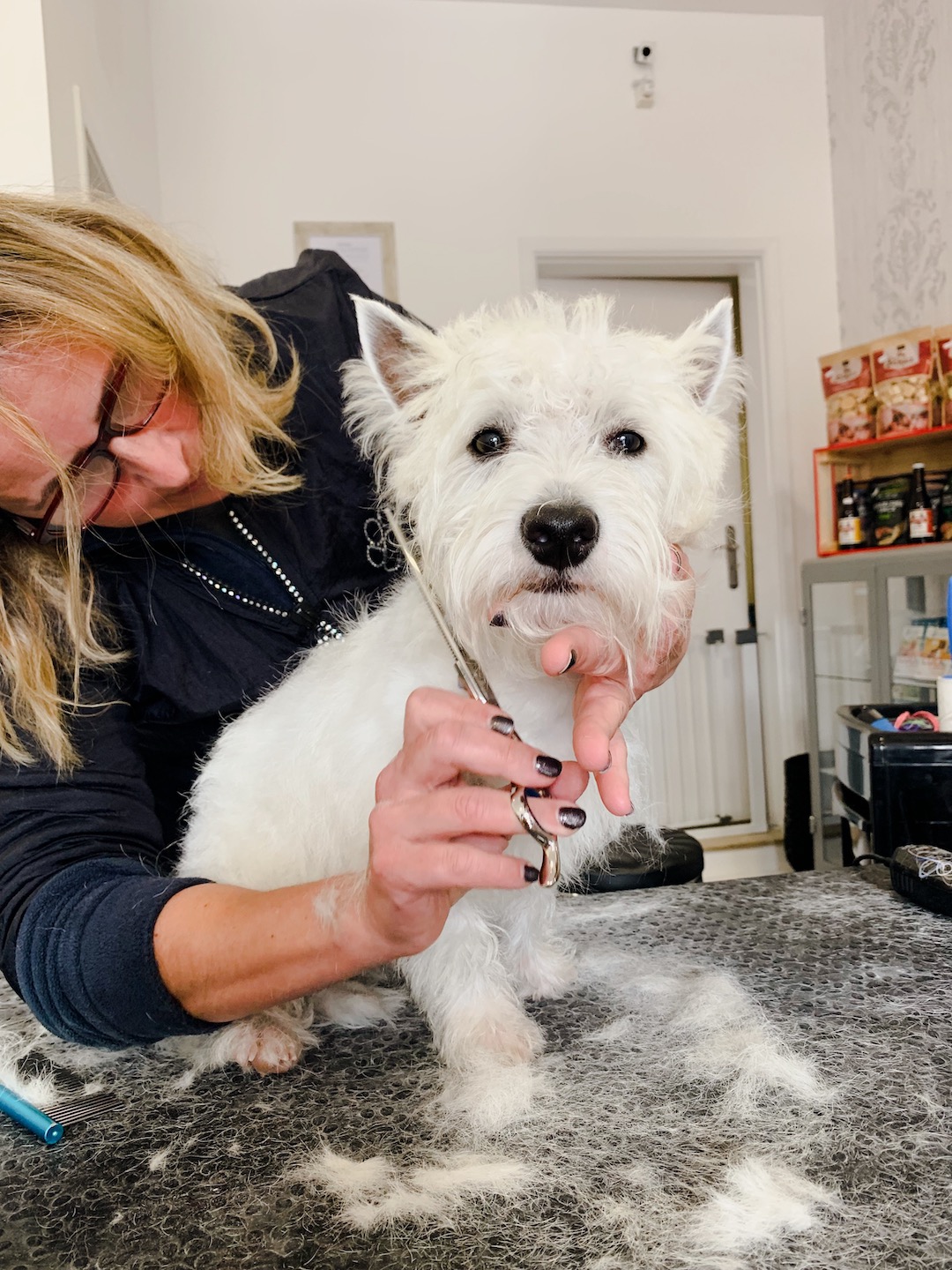
How do you groom a Westie? Brush and comb the dog every day, if possible. The fur should be stripped rather than just given an occasional trim. Stripping removes the dead hair and keeps the fur its brightest and it’s recommended every 8 weeks. Every 4-6 weeks plan to trim nails, give a bath and tend to the ears.
Do not feel overwhelmed by the idea of hand stripping the fur or the need to brush the dog each day. Each task takes only a few minutes and is an uncomplicated process once it becomes a part of your daily routine. Westies shed much less than many other dogs, so the time saved in fur removal in the home more than makes up for the few extra grooming steps the dogs need.
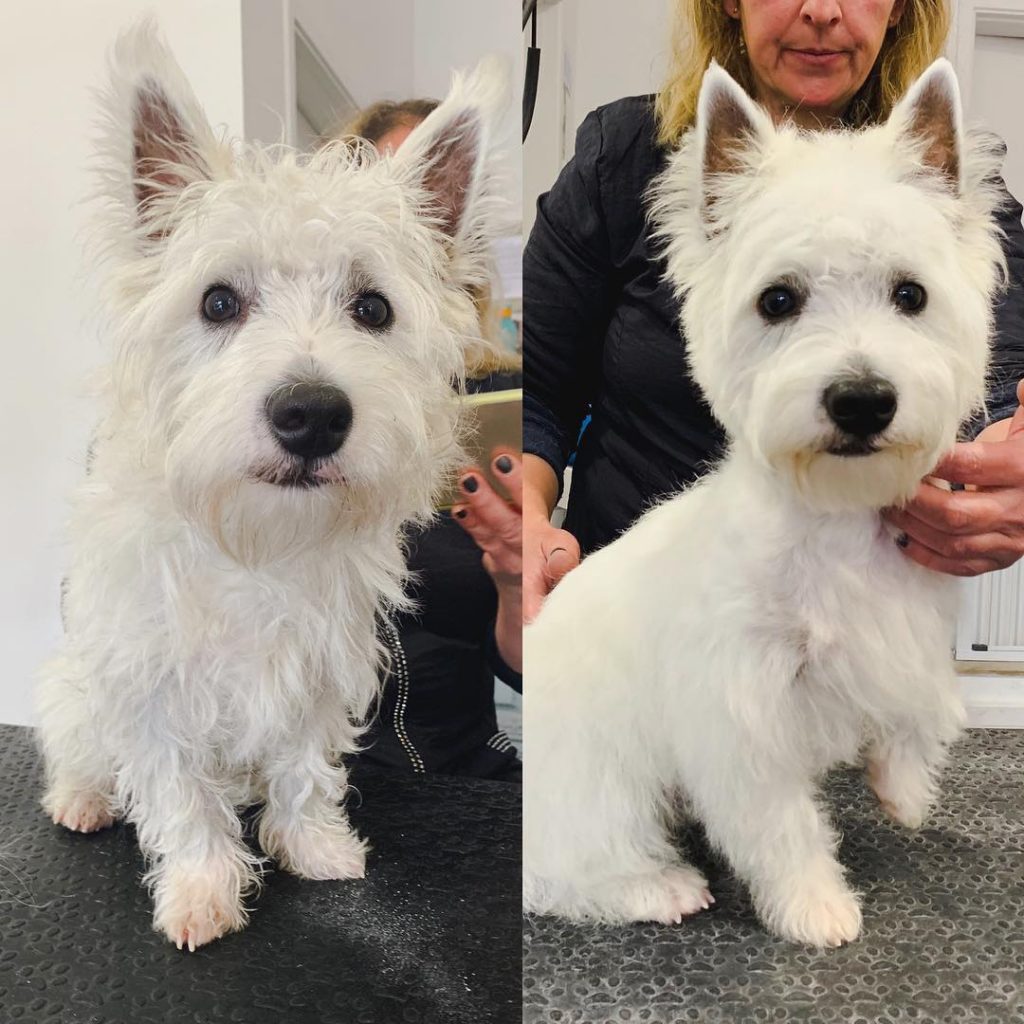
Plan a Schedule
Groom your puppy as soon as it arrives in your home. The easiest pets to groom are those that grow up with it as just another part of their life. Develop a schedule that makes it easy for you to stay on track with the needs of the dog.
- Spend 3-5 minutes to brush and comb the dog every day.
- Brush the teeth once a day, before bed.
- Strip the fur about once every 1-2 months.
- Bathe the dog, trim the nails and clean the ears with special dog ear cleaning drops every 4-6 weeks.
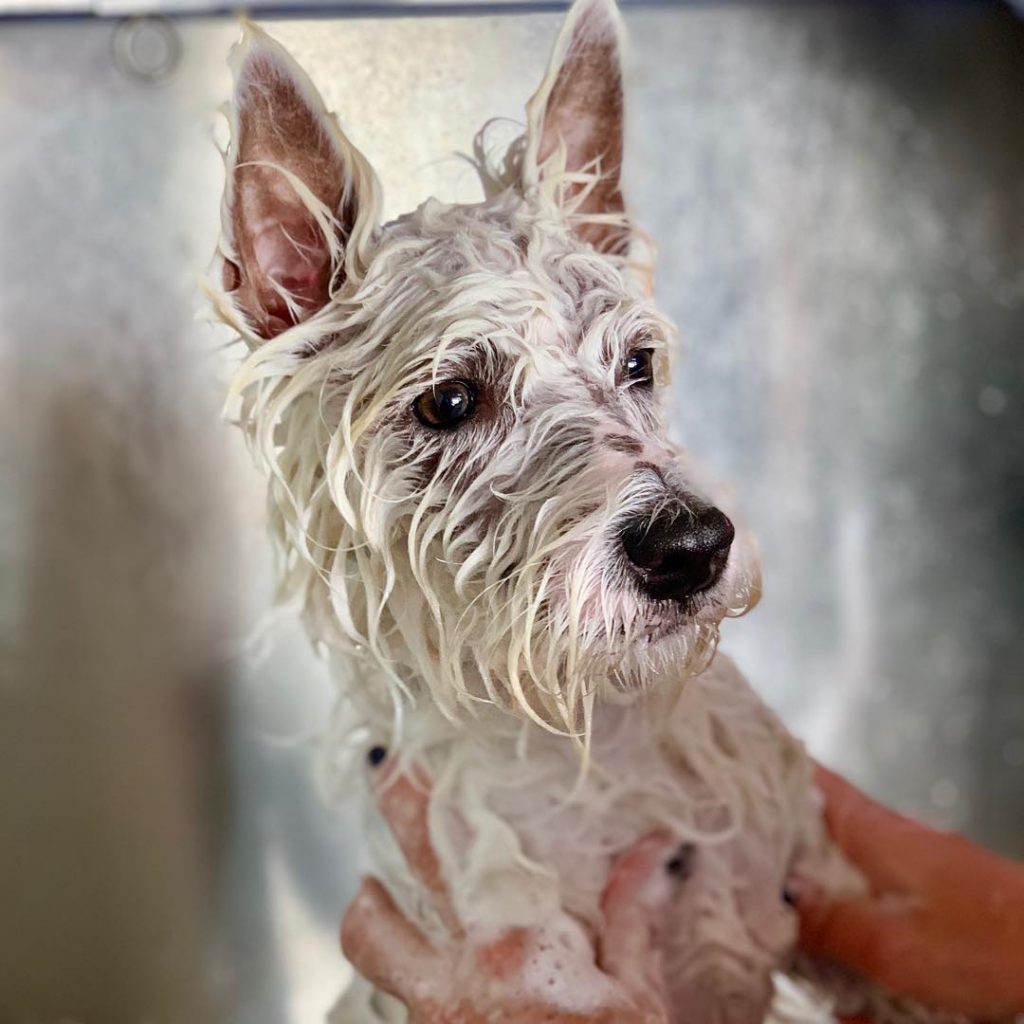
Brush the Fur
The purpose of the daily brush routine is to prevent any tangled fur and to remove dander and dirt. The Westie body sits low to the ground, so it is easy for dirt and debris to collect on them. The brushing also helps to boost blood circulation and distributes the natural oils in the fur for a healthier coat.
A quick wash with a soft, dampened cloth around the eyes and mouth can also help to reduce the risk of stains. To brush the dog effectively, use a brush with stiff bristles that can easily untangle the wiry hair. You can also use a rubber grooming brush to give your westie a nice, shiny coat. A steel comb is useful for the fur around the face and on tangled areas.
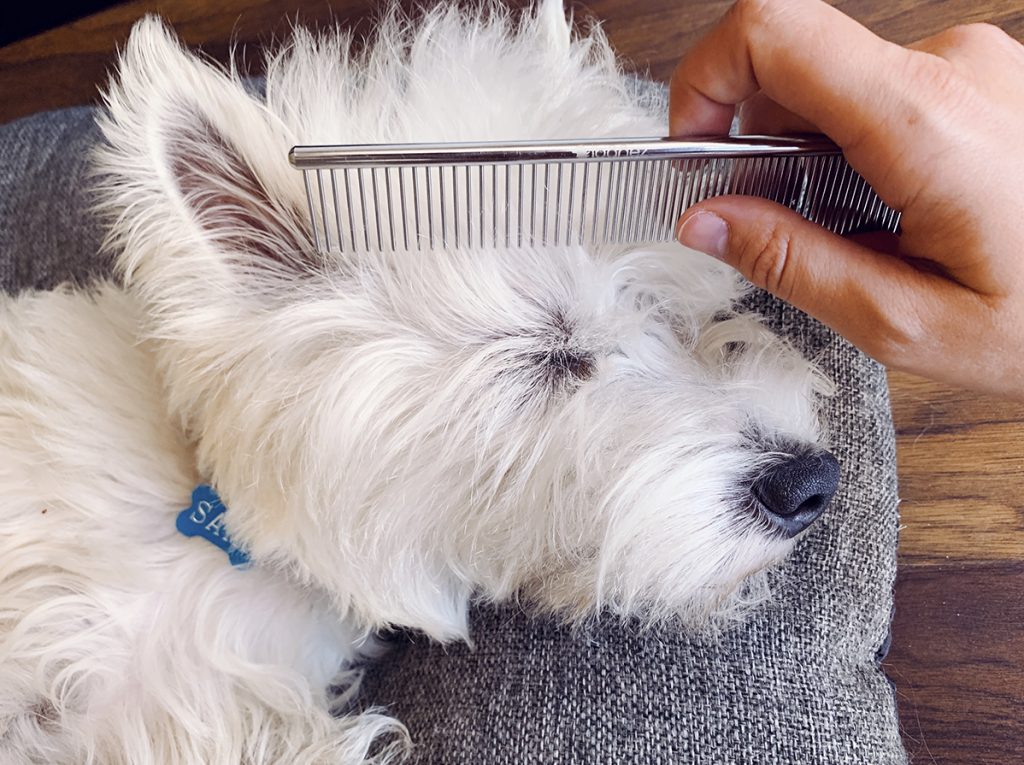
Know Style Options
It is possible to cut the fur of a Westie as it is any other dog. Skilled groomers typically know a variety of styles for Westies. The options include the traditional westie cut, the show look, and a teddy bear cut or puppy cut. The teddy bear cut has a round head, round feet and the overall cute look of a toy dog. The puppy cut keeps the fur short, so it is easier to keep clean. Over time, clipped fur can change in texture and become softer and even develop waves that did not exist before.

Westie fur stripping
The alternative to a cut is stripping. The process of stripping removes the older fur so there is room for the new fur to grow. The removal of the old fur avoids clogged follicles that could lead to skin irritation. Westies can suffer from skin conditions like skin allergies, atopic dermatitis, and yeast infections, and stripping helps to avoid these issues.
Learn to Hand-strip
Hand-stripping can seem barbaric to first-timers because you literally pull the fur out from the skin. However, the fur ready for stripping is dead and comes out without any effort or pain. Fur that does not come out easily should be left alone. The full body does not need to be done all at once, but all the fur needs to come out about once every 8 weeks. Owners can divide the fur into sections and work on a new section each week.
Place the dog on a solid surface and make certain they are secure. Choose the section to begin and grasp a few strands of the fur with your thumb and forefinger and pull gently. Continue in this manner until all loose hair is out.
Bathe Them Properly
Once every six weeks the Westie should have a full bath. Use a sensitive shampoo designed specifically for Westie (or sensitive) dogs. Needless to say if perfume isn’t on the ingredient list, even better. More frequent baths and harsh products can irritate the skin. Avoid the bath and schedule an appointment with your vet if the skin looks red and irritated or if you see a rash or sores. A yeasty odor is also a concern. Diagnosis and treatment of the skin condition should take place first to avoid aggravating the skin.
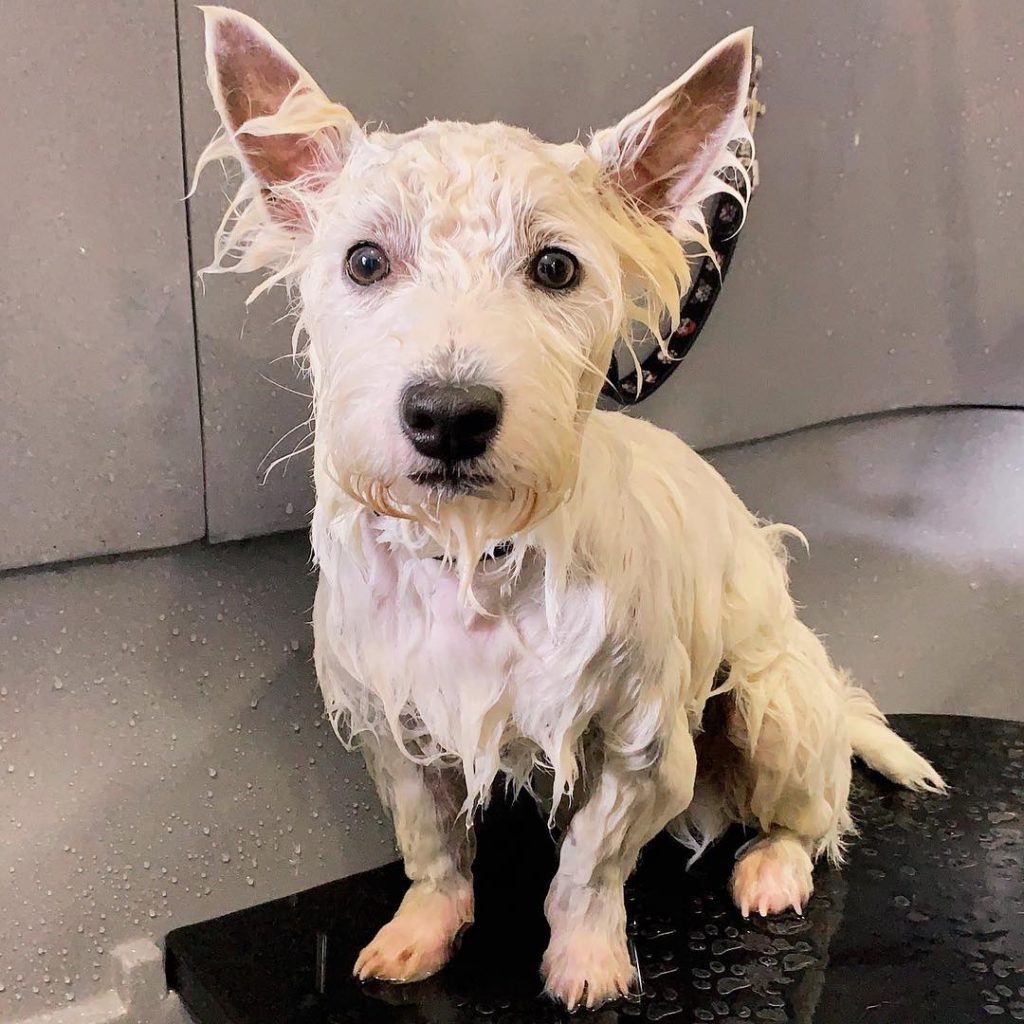
A second bath can take place after the initial cleaning if skin problems do not exist and the pet has shown no sensitivity to grooming products. The first wash removes all the debris in the fur and the excess oils from the skin. The second bath is to help whiten the fur, and a coat brightener shampoo is used for this purpose. The second bath is not a necessity, but some owners prefer their Westie to have sparkling white fur.
A bathing schedule can change if skin problems arise and how they change will depend on the type of condition. The vet may recommend a medicated shampoo and suggest more frequent baths until the problem subsides. Some conditions make it necessary to forgo bathing or stretch out the time between the cleanings.
Clear the Ears
The removal of ear wax and inspection of the ear canal is a normal part of grooming. Westies have an added need because of the fur that grows in the ear canal that may prevent proper drainage of the ears. Pull the fur to remove it from the ear. Take small amounts of fur with the help of tweezers and pull gently. Do not pull if the ears were recently infected or appear red or irritated. Trim the fur as close as possible with the tips of scissors instead.
After you remove the fur in the ears, apply a few drops of an ear cleaning solution designed for dogs into each ear. Massage the ears for a few seconds and then allow the pet to shake their head. Wipe away any wax or debris visible in the ear, but do not insert cotton swabs into the canal. Try another round of the cleaning solution if more wax is visible in the canal.
Brush the Teeth
Gum disease and tooth decay can become a problem for Westies as they reach middle age. Good dental care is as important for dogs as it is for humans because it prevents tooth loss and can improve overall health. Use a toothpaste made for dogs and place a small amount on a finger brush or on a soft cloth wrapped around your index finger. Massage the gums and teeth gently.
It takes about a minute of gentle rubbing to ensure all the teeth and the gums are cleaned. Toothpaste manufactured for dogs comes in flavors pets love to make the process more appealing to them. The paste is edible, and you do not need to rinse it out of the mouth. Tooth brushing is easier to perform with dogs that began when they were puppies.
We’ve written a more detailed article on this subject: Do you need to brush your westie’s teeth?
Related Questions
Can I cut and strip the fur? Yes, it possible to cut Westie fur and strip it too. Some people prefer short fur because it is easier to clean and less likely to get matted. Consider stripping as well as a trim if you want a short style but do not want to lose the wiry texture you love.
Do groomers offer stripping services? Not all pet owners have the time to strip fur and some worry they could hurt their pet. Many groomers offer the service, but not all. However if you live in a big city, finding a hand stripping groomer shouldn’t be a problem. Stripping the hair takes way longer than a trim, however, so expect to spend a few hours there and pay more for this service.
Can I protect my Westie from skin conditions? A high-quality diet and an allergen-free dog food protects against food allergies and dry skin. Flea preventatives, the use of natural shampoos, and good grooming help as well. However, skin irritations can occur on any dog, and even the most conscientious owner cannot prevent everything.



